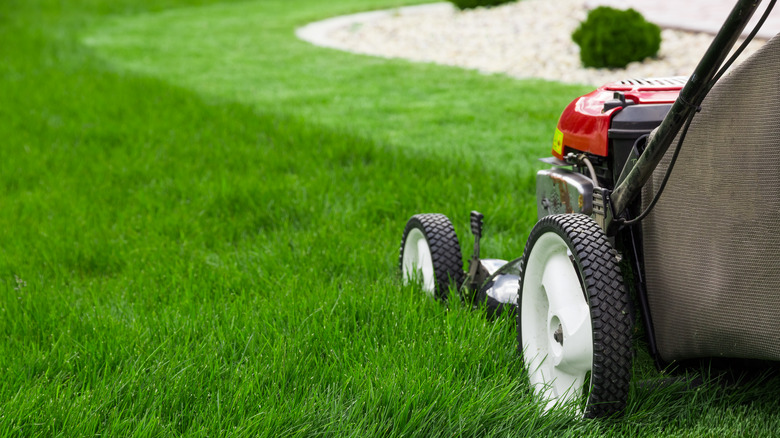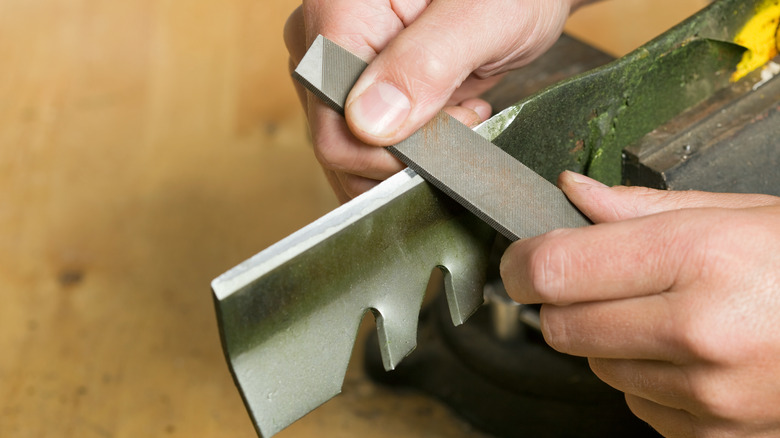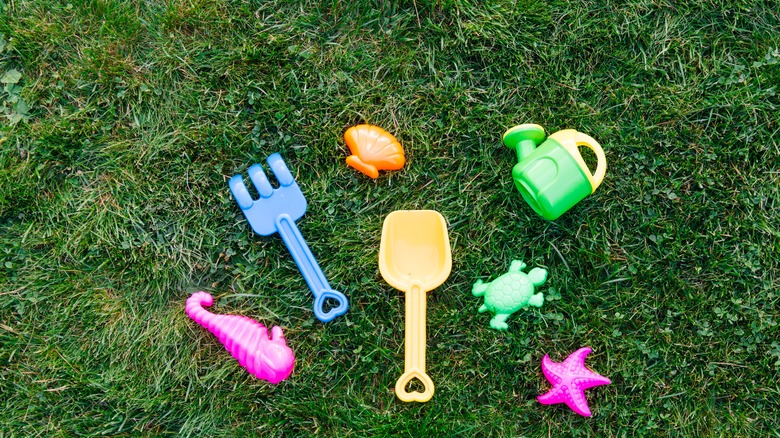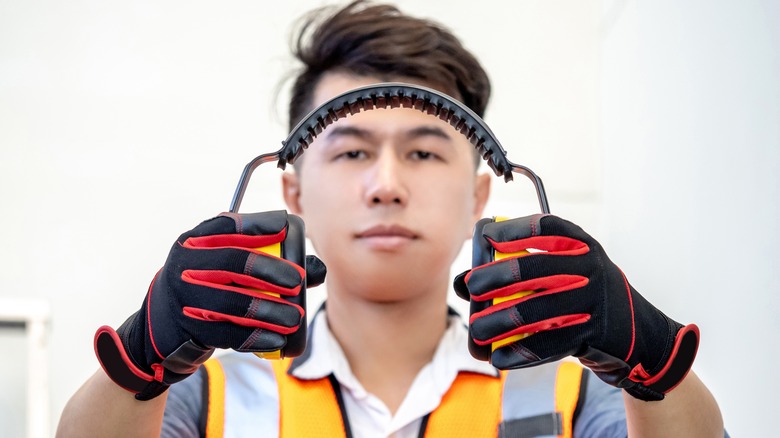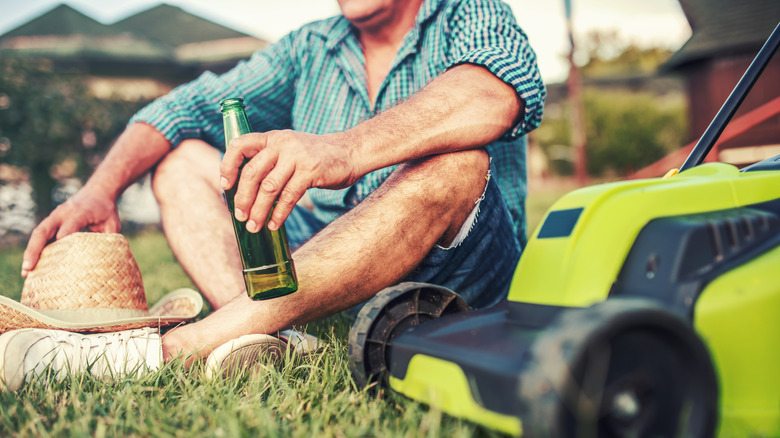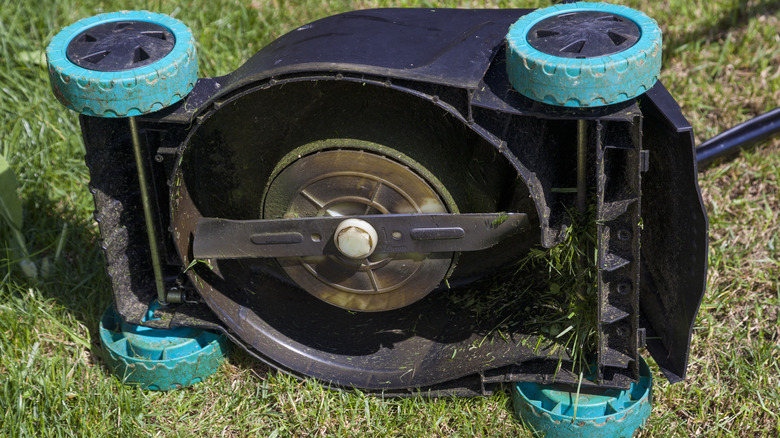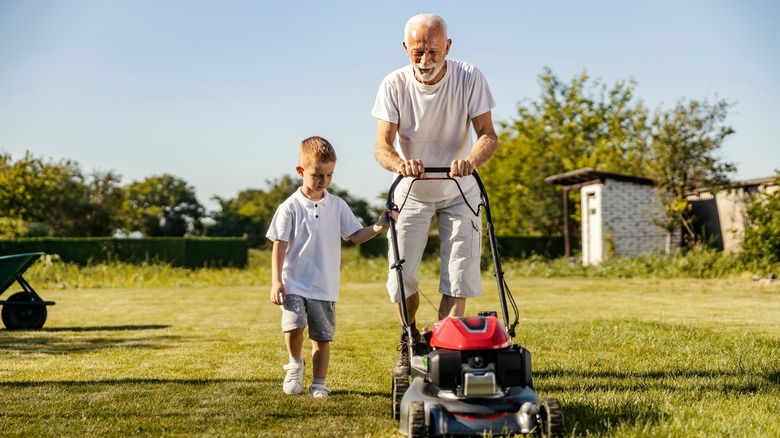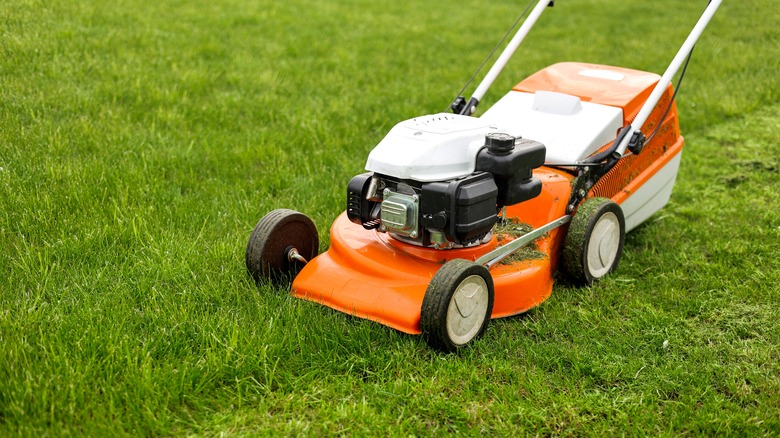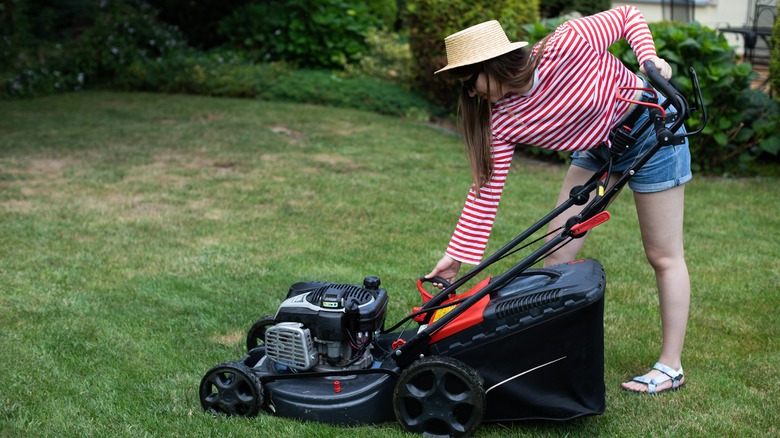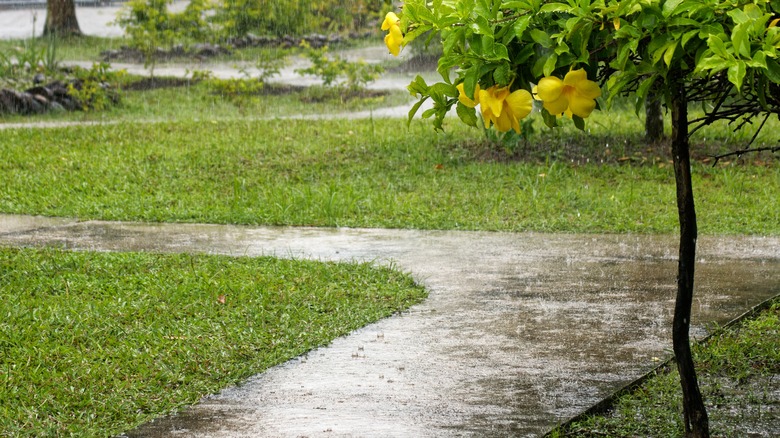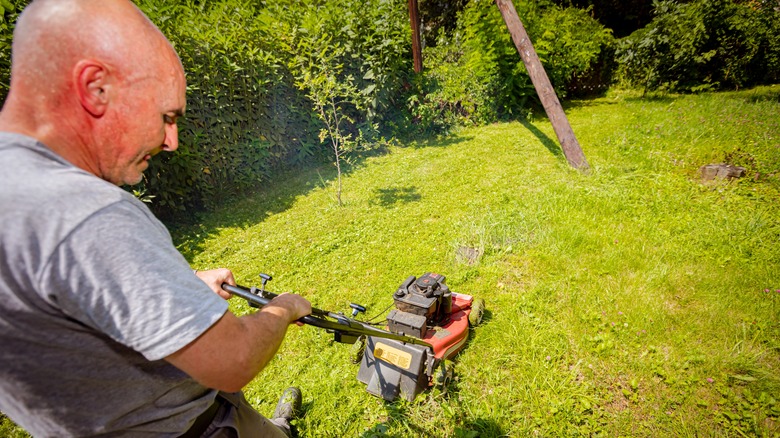9 Lawn Mower Safety Tips Everyone Should Know (& 1 Dangerous Mistake To Avoid)
Cutting your grass and preventing your lawn from getting overgrown is an important task that needs to be completed on a consistent basis. Lawn mowers — whether gas, electric, or even manual — help make this job quicker and easier to complete. However, lawn mowers are powerful tools with sharp blades. Despite the fact that they are relatively easy to use, you shouldn't let yourself make a mistake when mowing the lawn, or get complacent by assuming that nothing bad could happen.
In fact, according to a study published by The American Journal of Emergency Medicine, during the 10-year span between 2005 and 2015, over 900,000 people suffered a lawn mower-related injury. This works out to an average of more than 80,000 injuries each year. Knowing how to use a lawn mower safely and what you should and should not do when mowing the lawn can go a long way in protecting you from harm. Continue reading to learn some key safety tips to protect you — and others around you — when you're completing the necessary task of mowing the lawn.
Keep lawn mower blades safe to reduce risk of injury
Did you know that dull mower blades actually put you at a greater risk of injury than properly sharpened ones? While this may seem a bit counterintuitive, it is true. Because dull blades aren't sharp enough to cut off the tops of each blade of grass, they end up tearing the grass instead. As the grass rubs against the blades, it causes the blade to become rough. If you accidentally rub up against the blades, whether the mower is on or off, they're more likely to cause an injury.
Moreover, using a lawn mower with dull blades is one of the lawn care mistakes that may be killing your grass. As mentioned above, the dull blades tear the grass, which isn't good for the root system of the plant. If the root system gets damaged, you may find your lawn plagued by splotches of brown, dying grass. To protect your safety and the overall health of your lawn, it is important to know the best practices for sharpening your lawn mower blades. Keep in mind that the blades should be sharpened a minimum of two times each year (or after every 25 mows).
Always check the lawn for rocks, toys, or other items before mowing
Before you start mowing, it is crucial to walk across the lawn and pick up large sticks, rocks, toys, or other items that you could inadvertently run over with the mower. Beyond protecting your belongings from getting damaged by the sharp mower blades, skipping this step could potentially cause serious problems. When the mower is running, its blades are spinning rapidly. If these fast-spinning blades come into contact with a small item (or break a chunk of an item off), they could send it flying in any direction.
The projectile will have a lot of speed and momentum after getting struck by the blades, which means that it could cause significant harm to anyone (or anything) it comes into contact with. Running over obstacles with your lawn mower can also be a costly mistake. You could end up bending the blades, scratching the motor, or damaging the engine.
Wear protective gear when mowing your lawn
On a hot and steamy summer day, you may decide that wearing flip-flops and a pair of shorts when mowing is a good idea. However, this isn't a safe option. You must think about your safety and take steps to protect your body from accidental injury. There are several parts of your body that could get injured if something goes wrong as you're mowing, including your eyes, ears, and extremities.
To start, even if it is warm outside, you must wear closed-toe, sturdy shoes. If the mower accidentally slides over these, your feet will be much less likely to get injured than if you're only wearing flip-flops or sandals. Close-fitting, long pants and long-sleeved shirts are also a must. If any debris goes flying, or even worse, the mower blades somehow come into contact with your body, you'll be thankful that your skin isn't directly exposed and at greater risk of harm.
Beyond this more basic gear, you should also invest in a pair of work gloves, safety goggles, and ear muffs. Work gloves will not only protect your hands against injury, they can also help ensure you have a good grip on the mower to prevent other accidents. Goggles and ear muffs will protect you against flying grass clippings and other debris, as well as the loud noise of a mower.
Never operate a mower under the influence of alcohol
You know not to drink and drive, but a lawn mower isn't a car, and it shouldn't matter if you've had a few beers before heading out to cut the grass. Or, should it? Operating a lawn mower under the influence of alcohol is simply not a good idea. The reason that there are laws against drinking and driving is because alcohol can impair a person's ability to make judgments or reason soundly. It can also lower their inhibitions, making it more likely that they'll engage in risky behaviors. If you try mowing the lawn, whether with a push mower or a riding one, you could be putting your safety, or that of others, on the line.
If you do have a riding mower, you could even be putting yourself at risk for a DUI if you operate it under the influence of alcohol. DUI laws apply to operating a vehicle, and depending on the state where you live, a riding mower could be considered a vehicle. It simply isn't worth the risk involved to mow the lawn after drinking. Plan to mow before relaxing with a few beers, or simply wait until another day if you've already started drinking.
Keep your hands and feet away from the mower blades
You hear it every time you go to an amusement park: "Keep your hands, feet, and other objects inside the ride at all times." It may sound cliché, but there is a good reason they don't want you reaching your hands and feet out on a ride, and there is also a good reason why you should be careful to keep them away from the mower blades. Each year, thousands of people accidentally hurt their hands or feet while mowing the lawn. The blades are very sharp and cause serious harm to the body.
We've already discussed the need to wear protective gear to minimize harm to your body, but you should go a few steps further and avoid putting your hands or feet into the mower. For example, grass often gets caught up in the blades and can stop them from spinning properly. It may be tempting to flip the mower on its side and quickly pull out the clump of grass so you can get back to work. Don't do this; the blades could start spinning again before you get to pull your hand out, or you could accidentally rub up against them and cut yourself. If you need to use your hands or feet, you must first turn off the machine and disconnect the spark plugs (for gas models) or unplug the cord (for electric models) before doing anything.
Keep children away from the area and do not allow them to operate a mower until they are of appropriate age
Mowing is not a job for children. As we've already explained, there is a risk of injury even for adults when operating a lawn mower, so young children shouldn't be allowed to push a mower or drive a riding mower. Depending on the maturity level of the child, some will be ready to learn how to use a push mower when they are 12 years old or a riding mower when they are 16 years old. However, you should always use parental judgment, supervise properly, and make sure they are wearing protective gear.
Children younger than 12, however, should not only be prohibited from mowing the lawn, they should be kept inside when the adult is outside cutting the grass. There is just too much of a risk of injury, even if they aren't in the immediate vicinity of the mower itself. Children can be impulsive, and you don't want to risk of one running up to you when you're mowing. Moreover, lawn mowers are noisy, so you won't be able to safely monitor what your children are doing when you are mowing.
Always turn off the mower before walking away
Whether you're using a push or a riding mower, you should never walk away from it while it is still running. There are a few reasons why this is important. First, you're creating a potential safety hazard. Even if you're only stepping away for a second to grab a rock or a toy that is in the way, the mower could somehow start moving towards you. This, clearly, could result in a serious injury, especially if you somehow tripped or fell and were low to the ground when it ran into you.
Beyond the safety hazard it creates, leaving a mower running can also damage your lawn. When the machine is running, it is vibrating. This prolonged vibration, combined with its heavier weight pressing down over the same section of grass, could damage your lawn. You may end up with patches of very short grass or even sections where the grass is drying and turning brown. Even if you just have to walk away for a second, take a moment to cut the power to the motor first. You'll stay safer and you won't damage your lawn.
Never remove guards, covers, or safety devices
The guards, covers, and other shields on your mower can sometimes seem cumbersome or like they're in the way. However, these guards and other safety devices are there for a reason: to protect you when using the lawn mower. Some people advocate removing these devices to make a lawn mower easier to operate or more efficient to use. For example, a recent TikTok lawn mower hack recommends taking the bag off of the back of a mower to let the cut grass flow out, fertilizing the lawn with nutrient-rich clippings.
However, while this may sound like a good idea to some, it simply isn't safe. Lawn mower manufacturers add features, such as the back flap, to prevent lawn debris from flying out of the mower. Another safety feature that some try to override is the safety switch, also known as the kill switch. When the switch is released, the mower stops automatically. Trying to bypass this safety feature could have dire consequences. If you fall or trip while mowing and lose control of the machine, it could end up hurting you or others.
Let the grass dry before mowing
Mowing wet grass is a mistake you'll want to avoid. First, it can create a safety hazard. Wet grass can become very slick, making it more likely for you to trip and fall as you're mowing. This can be enough of a risk by itself, but when you add in the fact that you'll be pushing a heavy piece of lawn equipment, it is easy to see how you're putting yourself at even greater risk of harm — particularly if the lawn mower is running when you fall. If your yard has any hills, even mild ones, the risk of injury is even greater. Walking up or down a damp or muddy slope is even more challenging than walking across flat terrain, so you may be more likely to slip and fall or lose control of the mower.
While compelling, the safety concerns of mowing a wet lawn aren't the only reason you'll want to give the grass time to dry. Lawn mowers won't be as effective on wet grass. Some of the blades will be clumped together or bent down when you pass over them with the mower. This can result in a very uneven mow and a lawn that will look choppy once it does dry. The damp grass is also more likely to get clogged around the blades. This can be an inconvenience when you're mowing, because you'll have to pause more frequently to release the clog.
Pulling the mower backwards can be very dangerous
As you're mowing the lawn, you sometimes miss a patch of grass. At these moments, it can be tempting to pull the mower backwards to get the spot you missed. However, doing so is not a good idea. In fact, pulling a mower backwards can be very dangerous.
If you slip when pulling the mower backwards, you may lose control of the machine. Since it will already be moving towards your body, there might be nothing you're able to do to stop it from rolling over you, exposing your legs, arms, or even head and neck to the sharp blades. Instead of trying to save a few seconds by pulling it back over a patch of grass that you missed, take the time to turn it around and mow over it by keeping the mower moving forward. This way, if you somehow trip, the mower will be sent away from your body, not towards it.
